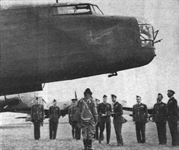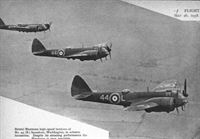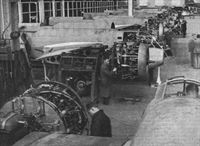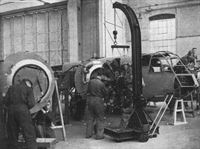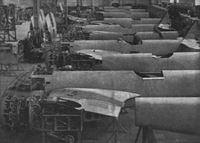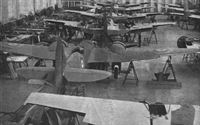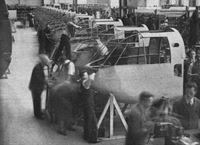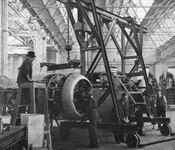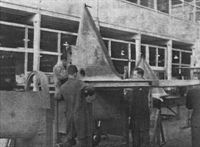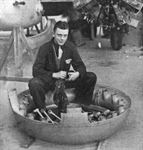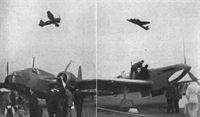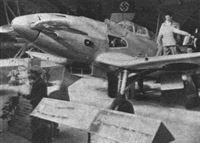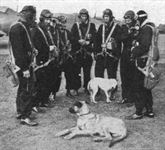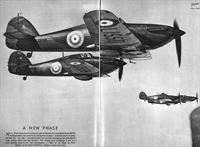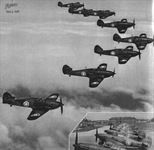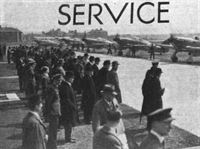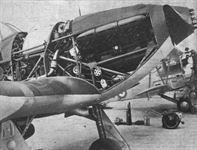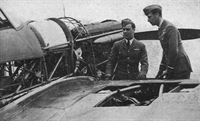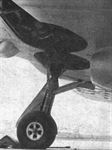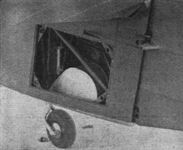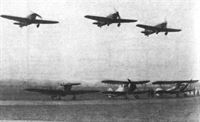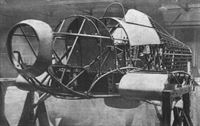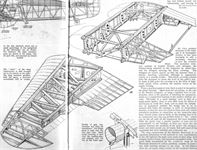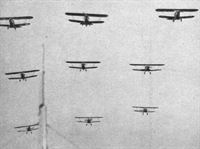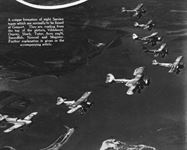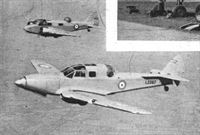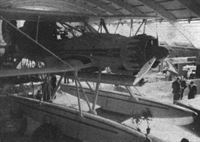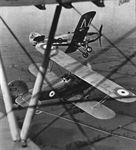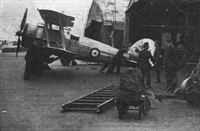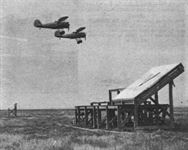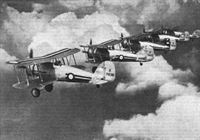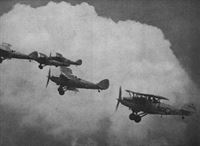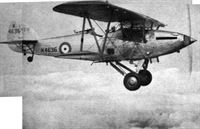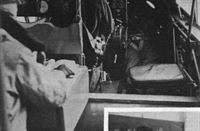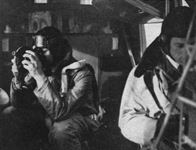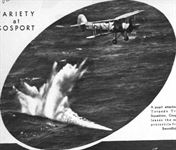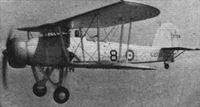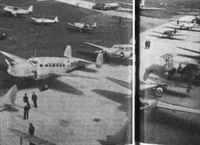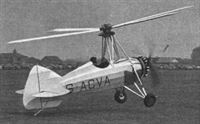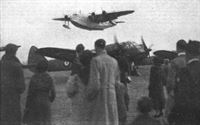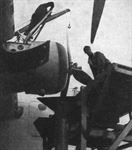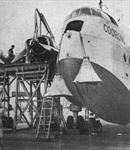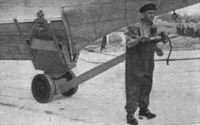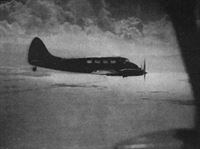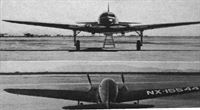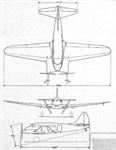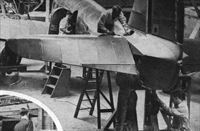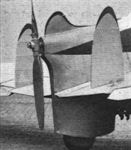Фотографии
-
The Rolls-Royce-Merlin-powered Armstrong Whitworth Whitley IV on test near the Aeroplane and Armament Experimental Establishment, Martlesham Heath.
Самолёты на фотографии: Armstrong Whitworth Whitley / A.W.38 - Великобритания - 1936
-
The King inspects machines of the Bomber Group. Above him towers the nose of a Harrow, and behind can be distinguished a Whitley, Wellesley and Blenheim.
Самолёты на фотографии: Armstrong Whitworth Whitley / A.W.38 - Великобритания - 1936Bristol Blenheim - Великобритания - 1936Handley Page Harrow / H.P.54 - Великобритания - 1936Vickers Wellesley - Великобритания - 1935
-
Регистрационный номер: K7191 The Armstrong-Whitworth Whitley (two Siddeley Tigers)
Самолёты на фотографии: Armstrong Whitworth Whitley / A.W.38 - Великобритания - 1936
-
ARMSTRONG WHITWORTH WHITLEY II and III: Bomber (two Tiger VIII engines 760 h.p. each at 12,750ft.); span, 84ft.; gross weight, 21,660 lb.; max. speed, 215 m.p.h. at 15,000ft.
Самолёты на фотографии: Armstrong Whitworth Whitley / A.W.38 - Великобритания - 1936
-
A specially prepared Flight drawing of the Tiger-engined Whitley bomber, a type used by several squadrons of the Royal Air Force. The speed is well over 200 m.p.h. with an impressive bomb load, the precise weight of which is undisclosed. The inset in the bottom right-hand corner shows the nose of the latest type of Whitley - the Mark IV - ordered for service with Rolls-Royce engines. It will be noted that ejector-type exhaust manifolds, which are very beneficial to performance, are incorporated.
Самолёты на фотографии: Armstrong Whitworth Whitley / A.W.38 - Великобритания - 1936
-
Bristol Blenheim high-speed bombers of No. 44 (B.) Squadron, Waddington, in echelon formation. Despite its amazing performance the Blenheim is very tractable.
Самолёты на фотографии: Bristol Blenheim - Великобритания - 1936
-
Fig. 1. - The rear fuselage portion of the Blenheim is an all-metal semi-monocoque structure. It has “developable” surfaces.
Самолёты на фотографии: Bristol Blenheim - Великобритания - 1936
-
Fig. 2. - Blenheim fuselages, with engines mounted, on the production line.
Самолёты на фотографии: Bristol Blenheim - Великобритания - 1936
-
Fig. 4. - A special crane brings the Mercury VIII engine up to the mounting. Note the pipes for taking air through the oil cooler.
Самолёты на фотографии: Bristol Blenheim - Великобритания - 1936
-
Fig. 6. - Nearly ready to “stand on their own legs.” A row of Blenheims in an advanced stage of assembly, showing the fitting of engines and controls.
Самолёты на фотографии: Bristol Blenheim - Великобритания - 1936
-
Fig. 10. - The final erection stage. Fitting wings, tanks, control surfaces, etc.
Самолёты на фотографии: Bristol Blenheim - Великобритания - 1936
-
Fig. 8. - Quantity production. Bristol Blenheim medium bombers on the line. They are being delivered to the R.A.F. and to several foreign governments.
Самолёты на фотографии: Bristol Blenheim - Великобритания - 1936
-
Fig. 9. - A special double - lifting crane is used for removing the main component assembly from its jig and transporting it to another station in the erecting hall.
Самолёты на фотографии: Bristol Blenheim - Великобритания - 1936
-
Начало сборки серийных "Бленхеймов" на заводе Бристоль
Fig. 11. - Ready for final inspection. Blenheims about to be passed to the production flight shed for flying tests before delivery.Самолёты на фотографии: Bristol Blenheim - Великобритания - 1936
-
Fig. 7. - Assembling the tail unit.
Самолёты на фотографии: Bristol Blenheim - Великобритания - 1936
-
Fig. 5. - Cleaning the stub pipes before assembly on the exhaust ring collector.
Самолёты на фотографии: Bristol Blenheim - Великобритания - 1936
-
Fig. 3. - The centre-section in its special erection jig, with one engine and one engine mounting fitted, and the rear fuselage portion attached.
Самолёты на фотографии: Bristol Blenheim - Великобритания - 1936
-
All in the picture: Westland Lysander over Vickers Wellington, and Bristol Blenheim over Fairey P.4/34.
Самолёты на фотографии: Bristol Blenheim - Великобритания - 1936Fairey Fulmar / P.4/34 - Великобритания - 1937Vickers Wellington / Type 271 - Великобритания - 1936Westland Lysander - Великобритания - 1936
-
BRISTOL BLENHEIM: Bomber (two Mercury VIII engines 840 h.p. each at 13,000ft.); span, 56ft. 4in.; gross weight, 12,030 lb.; max. speed 280 m.p.h. at 15,000ft.
Самолёты на фотографии: Bristol Blenheim - Великобритания - 1936
-
NAVAL CORPULENCE: The new Brewster single-seater fleet fighter for the U.S Navy powered with a Cyclone G Points to note are the method of retracting the undercarriage, the pilot’s headrest and the slinger ring-spinner over the hub of the Hamilton airscrew, which is likely to be of the new reversible-pitch type to retard speed in a dive
Самолёты на фотографии: Brewster F2A Buffalo / B-239 - США - 1937
-
Close-up of a modern German fighter - the Heinkel 112 with wing cannon and fixed machine gun “hatch” open. Young Finland is just stepping off the port wing roof after a glance at the works.
Самолёты на фотографии: Heinkel He-112 - Германия - 1935
-
Регистрационный номер: K4240 The Handley Page Hampden (two Pegasus) will very soon be in service in considerable numbers. The nose of the production type will be more rounded than in the photograph.
Самолёты на фотографии: Handley Page Hampden / H.P.52 - Великобритания - 1936
-
Регистрационный номер: D-ODBT The Henschel He.126 is a general-purpose machine particularly suitable for observation (army co-operation) work, due to its parasol layout.
The Henschel Hs.126 (B.M.W. 132DC) is a versatile German army-cooperation type bearing a distinct resemblance to the Douglas O-46-A (Pratt & Whitney Twin Wasp Junior).Самолёты на фотографии: Henschel Hs 126 - Германия - 1936
-
Pilots of No. 3 (F.) Squadron, Kenley, discuss formation flying in the presence of friends. The Squadron is armed with Hurricanes.
Самолёты на фотографии: Hawker Hurricane - Великобритания - 1935
-
Machines and personnel of No. 3 (F.) Squadron, the second unit to receive Hurricanes. The white objects in the foreground are used as signals to denote that QBI conditions are in force at Croydon.
Самолёты на фотографии: Hawker Hurricane - Великобритания - 1935
-
Регистрационный номер: L1550, L1559 [2] "Харрикейны" 111-й эскадрильи в полете, 1938 г. Самолеты первых серий не имели подфюзеляжного гребня.
NO. 111 (Fighter) Squadron from Northolt, with the Hawker Hurricane (Rolls-Royce Merlin) multi-gun fighter, may be said to be making Service history: as the first unit to be equipped with the “300 plus” monoplane fighter they are busy evolving the new technique of aerial warfare which that type demands. This striking aerial photograph is one of a series specially taken by the chief photographer of Flight for the Royal Air Force Pavilion at the Empire Exhibition, Glasgow, opened this week.Самолёты на фотографии: Hawker Hurricane - Великобритания - 1935
-
SOME of the machines of No.111 (F) Squadron
Самолёты на фотографии: Hawker Hurricane - Великобритания - 1935
-
A general impression of the scene at Northolt on Wednesday of last week.
Самолёты на фотографии: Hawker Hurricane - Великобритания - 1935
-
Forgings are used for attaching the diagonal drag members to the wing spars. On the left, a wing panel is seen in its jig.
Самолёты на фотографии: Hawker Hurricane - Великобритания - 1935
-
When the large detachable panels are removed there is very free access to the Rolls-Royce Merlin engine. The large tungum pipe shown is part oi the Glycol cooling system.
Самолёты на фотографии: Hawker Hurricane - Великобритания - 1935
-
ROYAL APPROVAL: H.M. King George VI inspects one of the Hawker Hurricanes at Northolt. With His Majesty is Sqn. Ldr. Gillan, who flew a Hurricane from Edinburgh to Northolt at more than 400 m.p.h.
Самолёты на фотографии: Hawker Hurricane - Великобритания - 1935
-
The split flaps of the Hurricane extend from radiator casing to root of aileron. They are hydraulically operated.
Самолёты на фотографии: Hawker Hurricane - Великобритания - 1935
-
The retractable undercarriage is raised laterally and inwardly, and the fairings cover the openings completely, leaving a smooth surface.
Самолёты на фотографии: Hawker Hurricane - Великобритания - 1935
-
The tail wheel retracts into the casing seen in the stern of the fuselage
Самолёты на фотографии: Hawker Hurricane - Великобритания - 1935
-
Регистрационный номер: L1559 [2] Hawker Hurricane Is of 111 Squadron, RAF.
Самолёты на фотографии: Hawker Hurricane - Великобритания - 1935
-
The general view shows the clean lines of the Hurricane.
Самолёты на фотографии: Hawker Hurricane - Великобритания - 1935
-
A flight of Hurricanes of No. 111 (F.) Squadron gets away over three representative fighter types - Hurricane, Gladiator and Demon I (with turret).
Самолёты на фотографии: Gloster Gladiator - Великобритания - 1934Hawker Demon - Великобритания - 1932Hawker Hurricane - Великобритания - 1935
-
The Hurricane fuselage in skeleton. The construction is of the type used by the Hawker Company with great success for many years.
Самолёты на фотографии: Hawker Hurricane - Великобритания - 1935
-
HAWKER HURRICANE: Fighter (Merlin II engine - 1,050 h.p. at 16,000ft.); span, 40ft.; total weight (approx.) 6,000 lb.; max. speed, 335 at 14,000ft.); span, 30ft.; gross weight, 3,609 lb.; max. speed, 223 m.p.h. at 16,400ft.
Самолёты на фотографии: Hawker Hurricane - Великобритания - 1935
-
In the side elevation but a small percentage of the equipment of the Hurricane can be shown. For instance, the eight machine guns are placed in the wings, four on each side, and operated by remote control.
Самолёты на фотографии: Hawker Hurricane - Великобритания - 1935
-
The “motif ” of the wing construction is well brought out in the sketch on the left. The drag members produce, with the spars, a structure remarkably stiff in torsion.
The centre-section of the wing (right) is a single unit bolted the fuselage at four points, carries the retractable undercarriage.
Details of spar construction and wing rib attachment (right bottom). The bridge piece is used over the rear spar only. Sheet metal covering is used over the leading-edge, and extends over the top of the front spar.Самолёты на фотографии: Hawker Hurricane - Великобритания - 1935
-
The graceful lines of the Fairey Battle are shown to advantage in this view of a flight of No. 12 (Bomber) Squadron, Andover.
Самолёты на фотографии: Fairey Battle - Великобритания - 1936
-
Handley Page Harrow bombers of No. 115 Squadron taxying in after a cross-country flight. The nose of a Battle gives a decorative touch.
Самолёты на фотографии: Fairey Battle - Великобритания - 1936Handley Page Harrow / H.P.54 - Великобритания - 1936
-
Регистрационный номер: K7650 The Fairey Battle with a single Rolls-Royce Merlin II
Самолёты на фотографии: Fairey Battle - Великобритания - 1936
-
During certain periods ground personnel are expected to work in their gas masks to accustom them to the “feel.”
Самолёты на фотографии: Fairey Battle - Великобритания - 1936
-
FAIREY BATTLE: Bomber (Rolls-Royce Merlin II engine - 1,050 h.p. at 16,250ft.); span, 54ft.; gross weight, 10,775 lb.; max. speed, 257 m.p.h. at 15,000ft.
Самолёты на фотографии: Fairey Battle - Великобритания - 1936
-
Регистрационный номер: G-ADHJ [2], G-ADHK [2] FULL-LOAD TRIALS: Twice last week the Short-Mayo composite made successful tests of separation with Mercury loaded to 20,800 lb. The trials took place off Felixstowe, and on the first occasion the machines were piloted by Short’s test pilots, Messrs. Parker and Piper. On the second they were flown by Sqn. Ldrs. Martin and Pickles, of the Marine Aircraft Experimental Establishment. With practically no wind, the take-offs were made in about 17 seconds. The picture shows Mercury being lifted by the Felixstowe crane. Maia can be seen afloat beyond the jetty.
Самолёты на фотографии: Short Mayo Composite (S.20 Mercury and S.21 Maia) - Великобритания - 1938
-
Регистрационный номер: G-ADHJ [2], G-ADHK [2] Mercury, upper component of the Short Mayo Composite, being lowered on to Maia prior to a full-load separation
Самолёты на фотографии: Short Mayo Composite (S.20 Mercury and S.21 Maia) - Великобритания - 1938
-
Hart Trainers, flown by instructors of No. 3 F.T.S., South Cerney, in an effective Empire Air Day formation.
Самолёты на фотографии: Hawker Hart - Великобритания - 1928
-
The same machines demonstrate “flights line abreast.” Folded blind-flying hoods may be discerned on the nearest aircraft.
Самолёты на фотографии: Hawker Hart - Великобритания - 1928
-
Back to those happy-go-lucky days: the old-timers’ park, with the Gordon-Bennett Bleriot flanked by two less racy Bleriots.
Самолёты на фотографии: Bleriot Bleriot-XI - Франция - 1909Bleriot Bleriot-XXVII Racer - Франция - 1911
-
THIS MILES HAWK TRAINER, completed recently, is claimed to be the first aeroplane to be assembled and partly built in India. It was built by the Aeronautical Training Centre of India under licence granted by Phillips and Powis Aircraft through their agents for India, R. K. Dundas, Ltd., of New Delhi and Portsmouth
Самолёты на фотографии: Miles Hawk / M.2 - Великобритания - 1932
-
The Westland Lysander, the newest Army co-operation machine ordered for the R.A.F.
Самолёты на фотографии: Westland Lysander - Великобритания - 1936
-
A unique formation of eight Service types which are normally to be found at Gosport. They are, reading from the top of the picture, Vildebeest, Osprey, Shark, Tutor, Avro 504N, Swordfish, Nimrod and Magister.
Самолёты на фотографии: Avro Avro 504N - Великобритания - 1920Avro Tutor/Sea Tutor/Prefect / Type 621/646/626 - Великобритания - 1929Blackburn Shark / B-6 - Великобритания - 1933Fairey Swordfish - Великобритания - 1934Hawker Nimrod - Великобритания - 1931Hawker Osprey - Великобритания - 1930Miles Magister / M.14 - Великобритания - 1937Vickers Vildebeest / Type 132 - Великобритания - 1928
-
Регистрационный номер: L4534 AIRSPEED OXFORD: Advanced trainer (two Cheetah X engines - 350 h.p. each at 7,600ft.); span, 53ft.; gross weight, 7,300 lb.; max. speed, 185 m.p.h. at 7,500ft.
Самолёты на фотографии: Airspeed Oxford / AS.10 - Великобритания - 1937
-
The Airspeed Oxford twin-engined trainer demonstrates its agility at Martlesham.
Самолёты на фотографии: Airspeed Oxford / AS.10 - Великобритания - 1937
-
Регистрационный номер: L2387 Two modern trainers; The De Havilland Don with a single D.H. Gipsyking engine and the twin-engined Airspeed Oxford. Both machines are being flown by Martlesham test pilots.
Самолёты на фотографии: Airspeed Oxford / AS.10 - Великобритания - 1937De Havilland Don / D.H.93 - Великобритания - 1937
-
Регистрационный номер: G-ADSR OUT AND UP. This unusual picture by a Flight photographer shows the Armstrong Whitworth Ensign tucking-up ner wheels as she takes off from her makers’ aerodrome. She was due to go to Martlesham yesterday.
Самолёты на фотографии: Armstrong Whitworth Ensign / A.W.27 - Великобритания - 1938
-
The big Arado 95 torpedo bomber floatplane in the German exhibition hall.
Самолёты на фотографии: Arado Ar.95 - Германия - 1936
-
Регистрационный номер: K5115 Adopted for high-speed target towing, the Hawker Henley has a Rolls-Royce Merlin engine.
Самолёты на фотографии: Hawker Henley - Великобритания - 1937
-
The Dornier Do.17 bomber has two Daimler Benz inverted vee engines and is capable of something like 280 m.p.h. Similar machines, with the older B.M.W. engines, have been in service with the German Air Force for a considerable time.
Самолёты на фотографии: Dornier Do.17 - Германия - 1934
-
Регистрационный номер: K6131 A Gloster Gladiator four-gun fighter breaks formation with the photographic machine. The Gladiator is the most advanced fighter biplane in service and is capable of 255 m.p.h.
Самолёты на фотографии: Gloster Gladiator - Великобритания - 1934
-
Регистрационный номер: K1929, K2071 A PAIR of Hawker Fury single-seater fighters of the Advanced Training Squadron, No. 3 Flying Training School, South Cerney, skating along on their sides in a “crazy formation” rehearsal for Empire Air Day.
Самолёты на фотографии: Hawker Fury - Великобритания - 1931
-
Регистрационный номер: K2048 HAWKER FURY: Fighter (Kestrel V engine - 640 h.p. at 14,000ft.); span, 30ft.; gross weight, 3,609 lb.; max. speed, 223 m.p.h. at 16,400ft.
Самолёты на фотографии: Hawker Fury - Великобритания - 1931
-
VICKERS WELLESLEY: Bomber (Pegasus XX engine - 925 h.p, at 10,000ft.); span, 74ft. 7in.; gross weight, 12,500 lb.; max. speed, 220 m.p.h. (approx.) at 10,000ft.
Самолёты на фотографии: Vickers Wellesley - Великобритания - 1935
-
The Junkers Ju.86K bomber with twin Junkers Jumo engines. Machines of this type equip a number of German squadrons.
Самолёты на фотографии: Junkers Ju.86 - Германия - 1934
-
AMERICAN SHOWMANSHIP: The mass formation is led by Northrop A.17.A attack machines, followed by Douglas B.18s, which may be regarded as the bomber derivative of the commercial D.C.2; Picture is from the M.G.-M. film Test Pilot, which has its premiere at the Empire Theatre, London, tomorrow (Friday).
Самолёты на фотографии: Douglas B-18 Bolo - США - 1935Northrop A-17 / 8A Nomad - США - 1934
-
Gauntlet single-seater fighters being put to bed in Bessoneau hangars at No. 3 Armament Training Station, Sutton Bridge. The transportable Bessoneau hangar, which was of great service during the war, still has its uses in the R.A.F. to-day.
Самолёты на фотографии: Gloster Gauntlet - Великобритания - 1929
-
A pair of Gloster Gauntlet single-seaters over the ranges at No. 3 Armament Training Station, Sutton Bridge.
Самолёты на фотографии: Gloster Gauntlet - Великобритания - 1929
-
Регистрационный номер: K7838, K7840 A close line-abreast by Gloster Gauntlet single-seater fighters. The Gauntlet has two guns, does 230 m.p.h., and is very manoeuvrable.
Самолёты на фотографии: Gloster Gauntlet - Великобритания - 1929
-
Hawker Hinds of No. 50 (B.) Squadron, Waddington, climbing in formation. The leader is in communication with the other pilots by R/T.
Самолёты на фотографии: Hawker Hind - Великобритания - 1934
-
Регистрационный номер: K4636 HAWKER HIND: Bomber (Kestrel V engine - 640 h.p. at 14,000ft.); span, 37ft. 3in.; gross weight, 4,958 lb.; max. speed, 186 m.p.h. at 16,400ft.
Самолёты на фотографии: Hawker Hind - Великобритания - 1934
-
Регистрационный номер: K8093, K8108, K8114 [2] Hawker Hector army co-operation machines of No. 13 Squadron, racks laden with practice bombs, in the act of making a diving attack on a ground
Самолёты на фотографии: Hawker Hector - Великобритания - 1936
-
Регистрационный номер: K8114 [2] HAWKER HECTOR: Army co-operation (Napier Dagger III engine - 805 h.p. at 5,000ft.); span, 37ft. 3in.; gross weight, 4,887 lb.; max. speed, 187 m.p.h. at 6,560ft.
Самолёты на фотографии: Hawker Hector - Великобритания - 1936
-
Регистрационный номер: K8468 BLACKBURN SHARK: Torpedo-spotter-reconnaissance (Tiger VI engine - 810 h.p. at 5,000ft.); span, 46ft.; gross weight, 7,870 lb.; max. speed, 152 m.p.h. at 5,500ft.
Самолёты на фотографии: Blackburn Shark / B-6 - Великобритания - 1933
-
A Supermarine Walrus and a Fairey Sea Fox glimpsed from one of the Felixstowe hangars.
Самолёты на фотографии: Fairey Seafox - Великобритания - 1936Supermarine Walrus/Seagull V - Великобритания - 1933
-
SAUNDERS ROE LONDON: Flying boat (two Pegasus X engines - 875 h.p. each at 6,250ft.); span, 80ft.; gross weight, 22,000 lb.; max. speed, 155 m.p.h. at 6,250ft.
Самолёты на фотографии: Saunders-Roe London / A.27 - Великобритания - 1934
-
NOT ANOTHER “COMPOSITE” - just a pair of Short Singapore flying boats (two Kestrel VIII and two Kestrel IX) of No. 209 (General Reconnaissance) Squadron practising near Harwich for their Empire Air Day display. This picture was secured from the third machine in the echelon.
Самолёты на фотографии: Short Singapore III / S.19 - Великобритания - 1934
-
Short Singapore IIIs of No. 209 (General Reconnaissance) Squadron, Felixstowe, through the window top machine in an echelon formation
Самолёты на фотографии: Short Singapore III / S.19 - Великобритания - 1934
-
A formation touch-down by Singapore IIIs of No. 209 (G.R.) Squadron.
Самолёты на фотографии: Short Singapore III / S.19 - Великобритания - 1934
-
SHORT SINGAPORE III: Reconnaissance flying boat (two Kestrel IX and two Kestrel VIII engines - 730 h.p. each at 5,250ft.); span, 90ft.; gross weight, 27,500 lb.; max. speed, 145 m.p.h. at 2,000ft.
Самолёты на фотографии: Short Singapore III / S.19 - Великобритания - 1934
-
SUPERMARINE STRANRAER: Flying boat (two Pegasus X engines - 850 h.p. at 4,000ft.); span, 85ft; gross weight, 19,000 lb.; max. speed, 165 m.p.h. at 6,000ft.
Самолёты на фотографии: Supermarine Stranraer - Великобритания - 1934
-
Avro Anson general reconnaissance machines in an appropriate setting with a flotilla of destroyers below.
Самолёты на фотографии: Avro Anson / Type 652 - Великобритания - 1935
-
In the air with one of the Ansons, looking forward. The navigator is at his chart table (with chart pockets and essential instruments in front of him) on the left, and a pupil is using the coursesetting bomb sight in the nose.
Самолёты на фотографии: Avro Anson / Type 652 - Великобритания - 1935
-
In an instructional Anson again, this time looking towards the tail. The radio operator is seen at work, and a pupil is using a bubble sextant.
Самолёты на фотографии: Avro Anson / Type 652 - Великобритания - 1935
-
The Blackburn Skua dive bomber fleet fighter just before diving tests at Martlesham Heath.
Самолёты на фотографии: Blackburn Skua / B-24 - Великобритания - 1937
-
Регистрационный номер: K5178 A dive bomber fighter for Fleet work, the Blackburn Skua has folding wings. A Mercury or Perseus engine may be fitted.
Самолёты на фотографии: Blackburn Skua / B-24 - Великобритания - 1937
-
A pupil attached to the Torpedo Training Squadron, Gosport, releases the massive projectile from his Swordfish.
Самолёты на фотографии: Fairey Swordfish - Великобритания - 1934
-
Atlantic patrol: Fairey Swordfish torpedo-spotter reconnaissance biplanes over their mother ship, H.M.S. Glorious. A machine of the same type is just landing-on.
Самолёты на фотографии: Fairey Swordfish - Великобритания - 1934
-
FAIREY SWORDFISH: Torpedo-spotter-reconnaissance (Pegasus III engine - 750 h.p. at 3,500ft.); span, 45ft. 6in.; gross weight, 7,720 lb.; max. speed, 154 m.p.h. at 4,000ft.
Самолёты на фотографии: Fairey Swordfish - Великобритания - 1934
-
Регистрационный номер: K4164 VICKERS VILDEBEEST: Torpedo bomber (Pegasus IIM engine - 635 h.p. at 5,000ft.); span, 49ft.; gross weight, 8,100 lb.; max. speed, 142 m.p.h. at 4,930ft. (Picture shows Vildebeest IV with Perseus engine.)
Самолёты на фотографии: Vickers Vildebeest / Type 132 - Великобритания - 1928
-
DELIVERED: A pleasantly informal snap from Hatfield, showing Aero O/Y pilots taking delivery of their Company's second D.H. Rapide. Left to right : Mr. Peter de Havilland, Flt. Capt. Raunio, W/O Nylund, Mr. Geoffrey de Havilland and Mr. George Gibbons.
Самолёты на фотографии: De Havilland Dragon Rapide / Dominie / D.H.89 - Великобритания - 1934
-
A few of the visiting machines on the tarmac at Helsingfors Airport last Sunday. The machine on the left is the L.O.T. Lockheed 14, while in the foreground, just to be seen, is one of the Aero O/Y two Rapides.
Самолёты на фотографии: De Havilland Dragon Rapide / Dominie / D.H.89 - Великобритания - 1934Lockheed Super Electra 14 - США - 1937
-
Регистрационный номер: K6993 Line-up of 214 Squadron Harrows photographed early in 1938 at RAF Feltwell.
Handley Page Harrow long-range bombers, showing the installation of the Nash and Thompson power-driven turret in the nose.Самолёты на фотографии: Handley Page Harrow / H.P.54 - Великобритания - 1936
-
HANDLEY PAGE HARROW II: Bomber (Two Pegasus XX engines - 925 h.p. each at 10,000ft.); span, 88ft. 5in.; gross weight, 23,500 lb.; max. speed, 200 m.p.h. at 10,000ft.
Самолёты на фотографии: Handley Page Harrow / H.P.54 - Великобритания - 1936
-
Vickers Valentia bomber-transports (two Pegasus) over Cairo. Though of somewhat antiquated type, the Valentia is still doing yeoman service out East.
Самолёты на фотографии: Vickers Valentia - Великобритания - 1934
-
Three-engined aircraft for long distance service on main traffic lines. ACCOMMODATION FOR 18/24 PASSENGERS. USEFUL LOAD 5000 Kgs. CRUISING SPEED 320/345 Kms.p.h. (199/211 m.p.h.). RANGE UP TO 2000 Kms.
The S.75 which, though it has the same power plant and general form as the S.83, is considerably larger.Самолёты на фотографии: Savoia-Marchetti / SIAI SM.75 - Италия - 1937
-
Twenty-four passengers can be transported at over 200 m.p.h. in the roomy cabins of the S.75, but the usual three-abreast arrangement is for 18 seats.
Самолёты на фотографии: Savoia-Marchetti / SIAI SM.75 - Италия - 1937
-
Регистрационный номер: G-AFGB This view give a good idea of the appearance of the prototype Arpin. The engine at present fitted is a 68 h.p. British Salmson.
Самолёты на фотографии: Arpin A-1 - Великобритания - 1938
-
Hendons oi No. 38 Squadron. The depth of the wing and the unusual cockpit arrangements are worth noting.
Самолёты на фотографии: Fairey Hendon - Великобритания - 1930
-
A Fairey Hendon bomber belonging to No. 38 (B.) Squadron takes off from Marham for an Empire Air Day rehearsal
Самолёты на фотографии: Fairey Hendon - Великобритания - 1930
-
Регистрационный номер: J9933 [2] A Hawker Demon two-seater fighter, showing the installation of the Nash and Thompson power-driven gun turret.
Самолёты на фотографии: Hawker Demon - Великобритания - 1932
-
Регистрационный номер: J9933 [2] HAWKER DEMON: Fighter (Kestrel V de-rated engine - 625 h.p. at 12,000ft.); span, 37ft. 3in.; gross weight, 4,490 lb.; max. speed 185 m.p.h. (approx.) at 15,000ft.
Самолёты на фотографии: Hawker Demon - Великобритания - 1932
-
Регистрационный номер: G-ACVA UP AND AWAY: An interesting little representative of the too-slowly-growing ranks of rotating-winged aircraft is the Kay gyroplane, which was demonstrated at the R.Ae.S. Garden Party. It has controllable-incidence rotor blades.
Самолёты на фотографии: Kay Gyroplane - Великобритания - 1932
-
INTERLUDE: On the face of it, hardly an air transport subject, this photograph of Mr. H. F. Broadbent (with two sentries and five porters), standing in front of his sun-protected Vega Gull at Sesok, on Flores, where he landed on his outward record attempt. Nevertheless, Qantas, K.L.M. and K.N.I.L.M., not to mention the Netherlands navy and the D.H. company, made it possible for a new airscrew to be sent and fitted in record time.
Самолёты на фотографии: Percival Vega Gull / K.1 - Великобритания - 1935
-
Регистрационный номер: G-ADUW [2] Castor moored in the Solent shortly before the war.
Самолёты на фотографии: Short Empire / S.23 - Великобритания - 1936
-
Регистрационный номер: G-ADUW [2] Castor on dry land. The surrealistic piece of mechanism is the beaching gear, with its buoys.
Самолёты на фотографии: Short Empire / S.23 - Великобритания - 1936
-
Регистрационный номер: G-AETW Somebody wanted to know if Calpurnia had been well greased underneath - just in case.
Самолёты на фотографии: Short Empire / S.23 - Великобритания - 1936
-
Регистрационный номер: G-AEUI [2], VH-ABE [2] A derrick, for which fittings are provided on the engine nacelles, assists in the servicing of the Pegasus Xc engines and D.H. airscrews. Note the oil-draining funnels on the staging.
Самолёты на фотографии: Short Empire / S.23 - Великобритания - 1936
-
Регистрационный номер: G-AEUI [2], VH-ABE [2] More surrealism: The curious objects depending from the bow hatch of Cooront; (a Qantas boat) are drogues, or sea-anchors, hung out to dry.
Самолёты на фотографии: Short Empire / S.23 - Великобритания - 1936
-
Tail wheels - and a nice line in nether garments.
Самолёты на фотографии: Short Empire / S.23 - Великобритания - 1936
-
At the Helsingfors Airport opening. Lt. Viisapaa, the <...> of the Finnish State Aircraft Factory.
Самолёты на фотографии: VL Viima - Финляндия - 1936
-
At the Helsingfors Airport opening. Lt. Viisapaa, the <...> of the Finnish State Aircraft Factory is seen in a low-down state of inversion <...> Viima trainer.
Самолёты на фотографии: VL Viima - Финляндия - 1936
-
ATTACHED:Imported for use of Col. Vincenzio Coppola, the Air and Military Attache to the Italian Embassy in Washington, this Cant monoplane has three 110 h.p. inverted four-cylinder Fiat engines. It was assembled at the Floyd Bennet Field.
Самолёты на фотографии: CANT Z.1012 - Италия - 1937
-
Регистрационный номер: I-LUCE, I-ESTE, I-ESTO Slot, flap and elevator treatment are shown well in this view of the S.83.
Самолёты на фотографии: Savoia-Marchetti / SIAI SM.83 - Италия - 1937
-
Luggage on both 83 and 75 is stowed below the cockpit and cabins. Either two-position or constant-speed Savoia-Marchetti metal airscrews can be fitted.
Самолёты на фотографии: Savoia-Marchetti / SIAI SM.83 - Италия - 1937
-
That the S.83 is no exception to the rule of neat grouping of controls and instruments on the modern transport machine may be gathered from the photograph.
Самолёты на фотографии: Savoia-Marchetti / SIAI SM.83 - Италия - 1937
-
Регистрационный номер: NX15544 [2] In a side view the Alcor C-6-1 does not appear to be unusual, although the forward position of the two airscrews is apparent. The Alcor Junior Transport seats eight.
Самолёты на фотографии: Alcor C-6-1 Junior - США - 1937
-
Регистрационный номер: NX15544 [2] Самолёты на фотографии: Alcor C-6-1 Junior - США - 1937
-
Самолёты на фотографии: Alcor C-6-1 Junior - США - 1937
-
In the news: The Boeing XB-15 bomber, which the newspapers delight in calling “the flying fortress.” At present it has four 1,000 - 1,100 h.p. P. and W. Twin Wasps.
Самолёты на фотографии: Boeing B-15 - США - 1937
-
CENTRAL ENOUGH: A Cessna seaplane on the ramp at one of New York’s “Skyports.”
Самолёты на фотографии: Cessna Airmaster / C-34 / C-38 / C-145 / C-165 - США - 1935
-
Four Osprey IIIs, K3616-3619, were delivered to the R.A.F for communications duties with No. 24 Squadron and later served with No. 1 C.A.A.C.U., as shown here
Hawker Ospreys of No. 1 Coast Artillery Cooperation Unit in their unusual camouflage.Самолёты на фотографии: Hawker Osprey - Великобритания - 1930
-
Регистрационный номер: G-AEXX, L7270 THE KING’S ENVOY: A pleasing impression of the Royal Airspeed Envoy (two Armstrong-Siddeley Cheetah IX), in which His Majesty toured between four representative Royal Air Force stations last Monday.
Самолёты на фотографии: Airspeed Envoy / AS.6 - Великобритания - 1934
-
Experience of modern aircraft construction is gained from the Blackburn H.S.T.10.
Самолёты на фотографии: Blackburn B-9 / HST.10 - Великобритания - 1936
-
Регистрационный номер: K2827 HAWKER NIMROD: Fleet fighter (Kestrel IIS engine - 550 h.p. at 13,000ft.); span, 33ft. 6 1/4 in.; gross weight, 4,042 lb.; max. speed, 181 m.p.h. at 16,400ft.
Самолёты на фотографии: Hawker Nimrod - Великобритания - 1931
-
Регистрационный номер: G-AFGG Making its public bow: The Marendaz Mark III, not quite finished but looking eager to go somewhere quickly. It seats four, and the motor is a Gipsy Six.
Самолёты на фотографии: Marendaz Mk III - Великобритания - 1937
-
The not-so-little brother of the Boeing XB-15, the YB-17, would be more likely to enter into the present argument, it has four 850 h.p. Cyclone G motors.
Самолёты на фотографии: Boeing B-17 Flying Fortress - США - 1935
-
AMERICAN SHOWMANSHIP: Boeing YB-17 four-engined bombers bring up the rear. The machines in the line-up below are also YB-17s. Picture is from the M.G.-M. film Test Pilot, which has its premiere at the Empire Theatre, London, tomorrow (Friday).
Самолёты на фотографии: Boeing B-17 Flying Fortress - США - 1935
-
The Sparmann S.1 single-seater trainer monoplane in the Swedish section. The makers of this machine are now in the Svenska Aeroplan A.B. group.
Самолёты на фотографии: Sparmann S-1 - Швеция - 1935
-
ITALIAN ECHELON: Caproni A.P.1. two-seater fighter-attack machines of the Regia Aeronautica put up a very creditable piece of formation flying.
Самолёты на фотографии: Caproni Bergamaschi A.P.1 - Италия - 1934
-
Регистрационный номер: NX20399 [2] Самолёты на фотографии: Tuscar H-70 - США - 1937
-
Регистрационный номер: NX20399 [2] ANOTHER PUSHER: Developed by Tuscar Metals, Inc., of New Philadelphia, this tailless two-seater cabin pusher is now under test. It is said to do 120 m.p.h. with a 95 h.p. engine.
Самолёты на фотографии: Tuscar H-70 - США - 1937
-
MID-WING: The New American Bennett monoplane, which may be considered as a small transport or luxury private-owner type, is interesting particularly because it is of mid-wing design and because it is of all wood construction. The engines of the prototype are Jacobs with Hamilton controllables, and the engine cowlings are unique in that there is no obvious gap between them and the nacelles. After its first test flight this machine was landed on its belly without structural damage.
Самолёты на фотографии: Bennett BTC-1 - США - 1937
Статьи
- Flight
- Flight Advertisements

